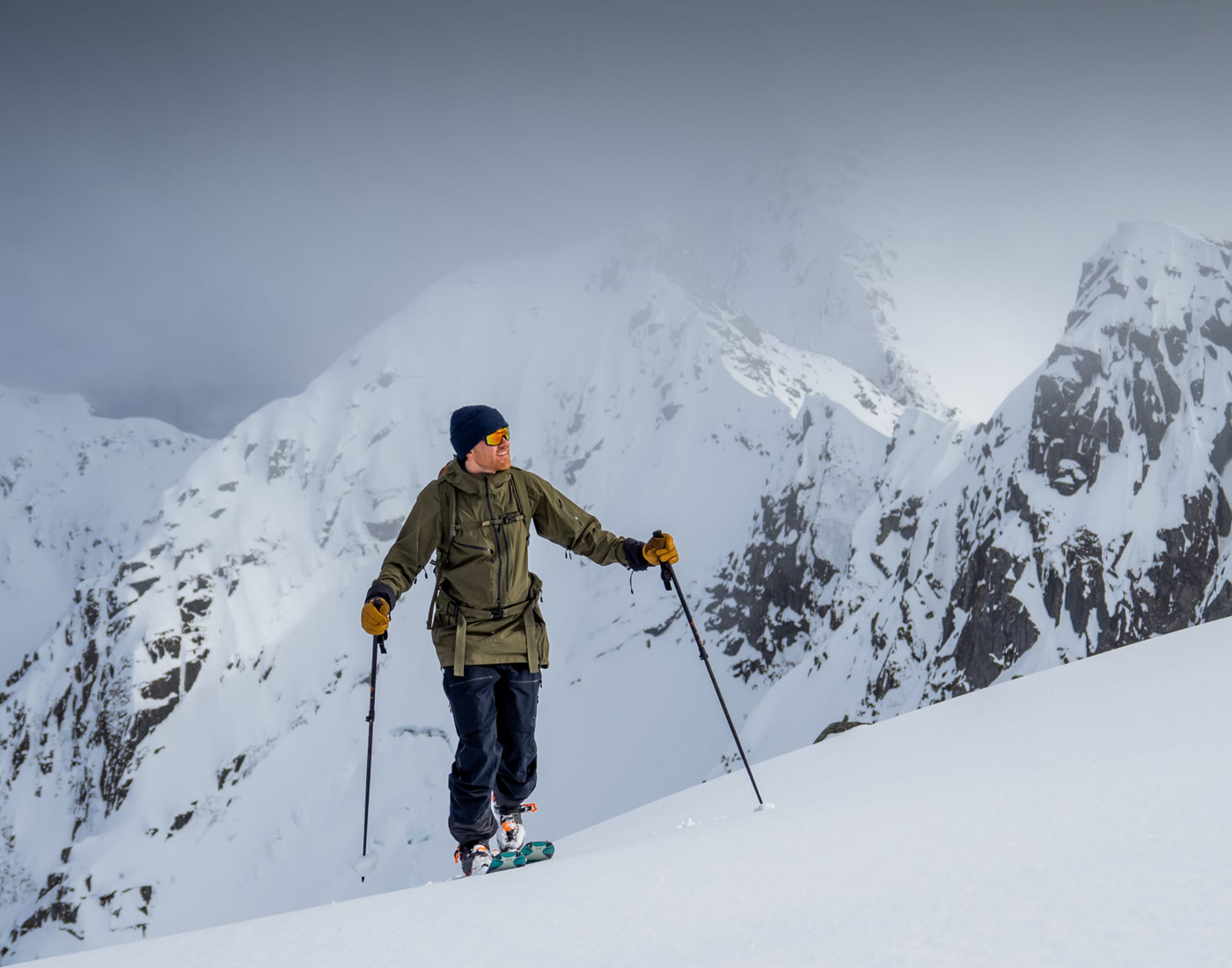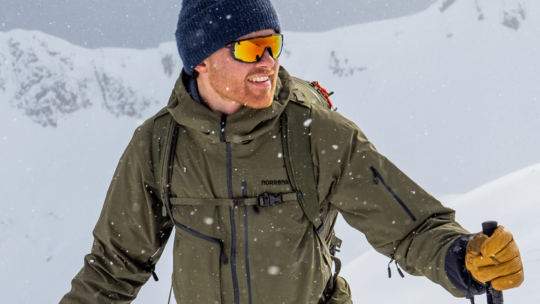
As liberating as it feels to ski in jeans, as nice as it is to wear some stylish wool sweater you found at the thrift store, the function of these garments just don’t work beyond Gaper Day. Deep storm days or high-alpine expeditions expose skiers to a variety of weather conditions; even terrain park laps or urban shoots at night can put a skier through a gauntlet of bone-chilling wind and snow. But with all of the multi-functional outerwear on the market, how can you sift through the fabric and find the kit that’s right for you? Reading our interview with the Director of Research, Development and Design at Norrøna, Fredrik Lundberg, would be a good start. He’s been at the helm of the Norwegian brand’s apparel evolution for over four years and has provided a few tidbits to consider before your next purchase.

Back in the 90s, specialized outdoor gear didn’t really exist. I needed to shape my own education based on normal fashion studies. My classmates thought I did a lot of boring stuff because I created military collections and fishing collections; collections for “functional use.”
I spent part of the season in Aspen in ‘93 and, at that time, ski wear made specifically for freeriding didn’t exist to my knowledge. My travel-mate to Aspen bought the coolest jacket I had seen in my life at that point—a Steep Tech anorak/jacket by The North Face, I think it was. Probably one of the first modern pieces made for serious extreme skiing. Back in the nineties, there weren’t many specific, activity-targeted collections. That suddenly changed around the early 2000s. Skiing was one of the first areas where outerwear brands focused their attention; I think it started with telemarking because downhill skiing had its “own brands,” so to say. Part of the industry is still there—making more generic, all-purpose gear—but the other part is definitely focused on activity-specific gear, like Norrøna, which has a good range of fine-tuned products.
Products can be born in various ways—that’s important to underline. The first question we ask ourselves is, “What do we want to do and what are our customers asking for?” Of equal importance, of course, is to talk to our ambassadors. What kind of challenges do they face? What needs do they have? What problems can we solve for them? These athletes have a lot of input, which is more based on experience.
We’re totally dependent on field testing. We can’t test everything internally and in-house, it needs to go outside. There’s no way around it. It takes about four years to get from an idea to the consumer. Not only do we have ambassadors assigned to each product’s development, we also have many internal people testing every piece.
You must ask yourself which type of skier you are. That translates into which type of gear you should look into. If you ski tour a lot and that’s your primary activity, then it’s useless to buy something which is made for piste-skiing. Fit comes second. You want to make sure you have outerwear that will not restrict you, something that will be comfortable over time. Then comes materials… and fourth is features. You need to go all in—get nerdy—to better understand your activity and relate that to products and their features.
Think about layering. [It’s important] to build a “costume,” so to say—a flexible setup that can tackle all kinds of weather and situations. There’s still room for education on the principles of layering, that doesn’t come automatically. We need to remind ourselves, and I remind the people closest to me, that it’s so important. I recommend that you have very flexible clothing: This includes baselayers, fleeces, different insulations and so forth, so you can adjust everything during the day depending on the situation and conditions.

Two-layer (2L) vs. Three-layer (3L) Construction
These terms relate to the outerwear’s membrane and protective layers. A membrane always has a face fabric bonded to the exterior and will then have a third layer bonded to the inside [3L] or have a liner sewn in [2L] to protect the membrane, which must be kept clean in order to work effectively.
Durable Water Repellent
If the face fabric that the membrane is bonded to soaks through, it renders the membrane pretty much useless. Durable Water Repellent (DWR) is a hydrophobic coating applied to the outside in order to keep the face fabric dry.
Seam Taping and Welding
When outerwear is sewn together, it creates holes around the seams and zippers, which allow water to penetrate the garment. These areas are taped over or welded together to prevent soaking. Sometimes, only areas most susceptible to this are taped, which is called “strategic” or “critical” sealing.
Insulation
Insulation, in short, keeps you warm. A piece of insulated outerwear either has down, a bird’s inner layer of feathers, or a synthetic material, which mimics down’s warmth. Areas more susceptible to loss of heat, like the torso, are often reinforced with heavier insulation.
Down’s warmth is measured by fill power, a rating derived from a test where one ounce of down is packed into a graduated cylinder. The volume occupied, in cubic inches, is its fill power, and a high number such as 800 indicates incredible warmth, while those below 500 suggest lighter insulation. Down is incredibly packable and has a high warmth-to-weight ratio.
To measure a synthetic insulation’s warmth, a one-meter-by-one-meter sampling of the synthetic insulation is weighed, and a higher weight, in grams, equates to more warmth. While not quite as warm or compressible as down, synthetics are often more water-resistant.
Waterproof and Breathable Membrane
The membrane is the most important part of waterproof and breathable outerwear but one which you never see. It’s laminated underneath the face fabric and has pores small enough to stop water from getting in (waterproofing), but large enough for water vapor to escape (breathability).
Waterproof and Breathability Ratings
A garment’s waterproof rating is often derived from a water column test or similar variation. A one-inch square tube is positioned on top of a piece of fabric and filled with water until it penetrates the membrane. The amount, in millimeters (mm), the fabric can take before soaking is its rating: 10,000 mm would be a 10K rating. A test measuring the amount of water vapor that permeates a square meter of fabric over 24 hours produces a garment’s breathability rating, which is shown in grams per meter squared per day (10,000 g/m2/d, or 10K).

Norrøna lofoten Gore-Tex Pro Anorak
Norrøna lofoten Gore-Tex Pro Pant
The all-new Gore-Tex Pro Anorak is the latest addition to Norrøna’s acclaimed lofoten lineup and the first piece in our list of the best ski outerwear this year. Answering the plea from its ambassadors to design a multi-use, extremely weather-resistant outerwear piece, the Anorak offers a relaxed, freeride silhouette with technical detailing that’ll stand up to the most severe weather at high-altitude. It’s made with 100-percent recycled Nylon face fabric along with Gore-Tex Pro technology but its various features are the real talking points here. The asymmetrical, long fit of this pullover extends over the crotch and provides great venting with two side zippers that extend from the pit to the waistline. When both sides are unzipped, you’ll be able to quickly cool your core temperature without sacrificing protection from the elements—a trademark of this jacket. A kangaroo-pouch allows you to store larger gear, like skins or extra goggles; the easy-to-use hood cinch adjusts its fit while maximizing protection from the elements; and every zipper is water-proofed.
The updated lofoten Gore-Tex Pro pant has been in the Norrøna collection since the mid-2000s and, this year, the designers have added some updated features to make it more functional than ever. Constructed with ultra-durable cuff reinforcements and accepting three different zip-on bib attachments (sold separately), the regular-fit pant—not too skinny, not too baggy—offers a comfortable feel when touring as well as resort skiing. Three pockets make it easy to store essentials and three-quarter length zips along the leg help dump heat quickly when needed. The tough, 200-denier Gore-Tex face fabric is made of recycled materials and contributes to a build that’ll last you year after year… and then some.

